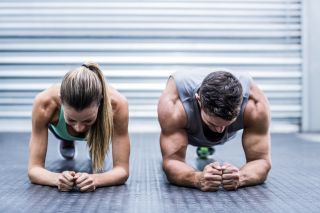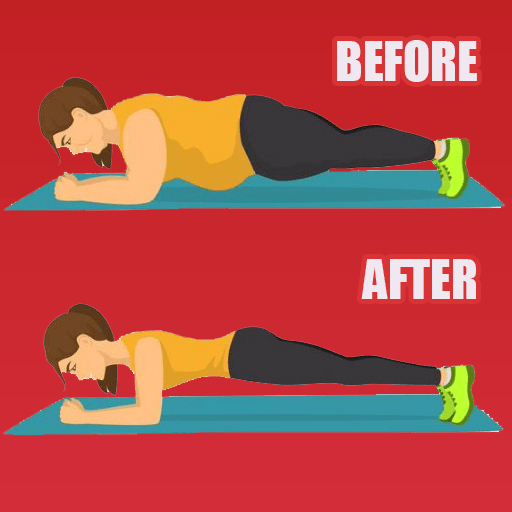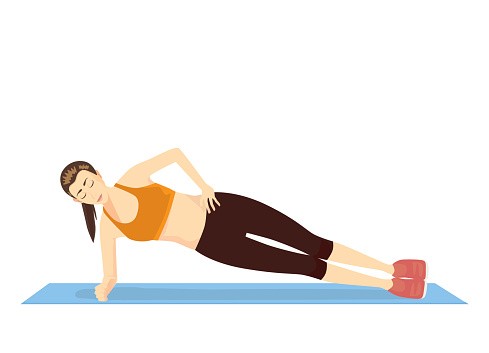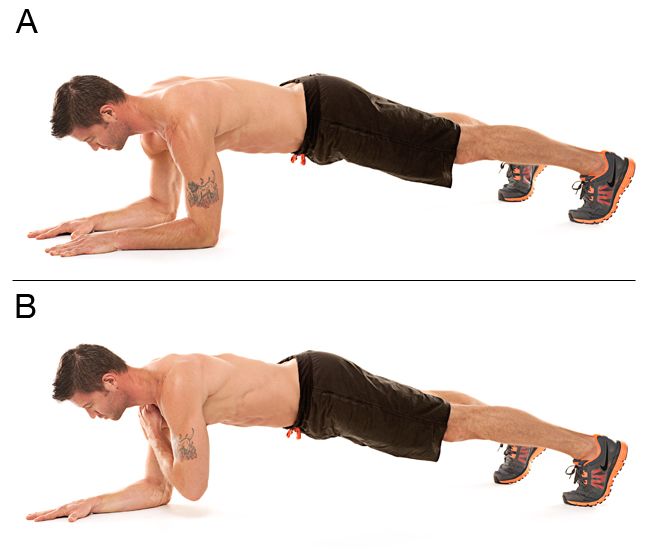Your mind is being louder and louder about doing physical exercises every day? You feel like doing something, but all the exercise routine scares you off? Want something efficient and yet not too burdensome? If you answered ‘yes’, then our 30 day plank challenge for beginners will be your magic pill. Plank is a treasure trove for those who want to be fit and have toned core and muscles, yet they struggle to find time for exercising. Not only will this challenge make you fitter, but it will also improve your emotional state. How is it possible? Let’s find out together!
Page Contents
What Are The Benefits Of A 30-Day Plank Challenge For Beginners?
When you see people planking, you probably wonder why someone would do it. Such challenges look pretty simple, and it’s not a big deal to keep your body like that, let alone the benefits of planking for health. However, that’s a very big delusion. Plank is nothing but a sack of benefits and perks for you. Let’s have a closer look at the benefits of a beginner 30-day plank challenge.
-
Abs
Plank exercises strengthen your ability to brace your abdominals (otherwise, the performance will not be correct). Planks also activate other related muscles, such as your glutes (muscles in your buttocks), hamstrings (muscles in the backs of your thighs), and lower back [1].
-
It Is A Full-Body Workout
Planks are especially advantageous for people who have a sedentary work style. Sitting long hours daily keeps your muscles deactivated; thus, you may have sore back and joints. When doing a plank correctly, you engage your abdominals and low back and help stretch your hip flexors, which get shortened during prolonged periods of sitting.
The primary focus of planks is on the core muscles and lower back, but they also work your shoulders, chest, triceps, biceps, back, and legs.
-
Strengthens Your Spine And Back Muscles
Studies suggest that a properly performed plank effectively activates the muscles responsible for spinal stabilization. It targets the entire core, as well as strengthens your shoulders and glutes – these muscles help improve posture, which can also help alleviate back pain.
-
Boosts Your Metabolism
Planking engages your whole body into tension. It gives a boost to your post-workout metabolism. Therefore, you burn more calories throughout the day, even when not working out.
-
Helps Improve Your Posture
Sitting and working long hours, our muscles become saggy – they don’t help you keep your spine straight; they allow you to slouch. Instead of using the muscles to provide stability, we exploit our bones. If you maintain such a position regularly, it leads to poor posture, which is harmful to the work of your organs, and, of course, your physique suffers a lot. If you don’t start exercising to strengthen your back muscles, you will join the ‘desk jockey’ posture club. Sounds funny but feels less amusing.
Planks significantly strengthen the muscles without applying significant pressure to the hips and spine. Your muscles will work more effectively, and on the whole, you will have less back discomfort. In addition, when you see a person with good posture, they seem healthier and more confident.
-
Improves Your Balance
What does body balance mean? It is an even distribution of body weight, which helps someone remain upright and steady, preventing falling, especially regarding elderly, who keep losing balance due to medical conditions [2].
There’s an easy way to check your balance:
Stand on one leg: You should be able to stand for > 30 seconds without swaying or losing your balance if you’re close to this goal; great!
If you feel weakness and muscle shaking, then you need some improvements. The main supporter and primary source of your balance is your core, which maintains your stability and upright posture.
The planks improve the balance of the body and your general ability to perform all types of fitness activities.
-
Can Have A Positive Impact On Your Mental Health
Your mental well-being also falls under the benefits of the 30 day plank challenge.
First, planks positively affect your mood, as they tone and stretch the muscles that contribute to tension and stress. It helps your brain to relax and decrease anxiety levels.
Planks can benefit your after-work physical exhaustion. If you spent a day sitting at the table, your legs are probably swollen, and your brain is about to explode. The right thing to do is to add the activity rather than sit on the sofa.
Yet another reason is the “I-can-do-it” feeling, which is worth all the money in the world. When you start doing a basic plank, 30 seconds seem to be an eternity. But when you can hit 2-3 minutes, your brain will celebrate the victory insanely, flooding you with feelings of pride and happiness [3].
How To Do A Plank
Plank, like other exercises, has its basic form as a variation for more accessible and challenging workouts.
If you want to reap all the benefits from this workout, you need to respect the rules. Otherwise, you fail to see the advantages and may end up with injuries.
The procedure:
- Lie down with your stomach on the ground. Bend your elbows and bring them to your shoulders to form a 90 grades angle.
- You have to bring your body, from head to heels, to a relaxed position, as if it was a straight line. Remain resting on your forearms or, if you prefer, on your hands.
- The feet must be on the toes. Keep your head and neck straight.
- Hold this position as long as you can, keeping your body in a straight line.
- The longer you can keep like that, the more advanced level you’re going to get.
Besides the posture, the other fundamental thing is to keep contracted muscles of the abdomen and buttocks for the entire exercise.
Do not force yourself more than you should. Listen to your body – if you can’t hold any more, have a short break. Time and practice will train your endurance; don’t expect to get everything at once.
How Long Should I Plank?
The duration depends on your initial fitness level and muscle strength. When starting a plank challenge, don’t set too high goals. Smaller steps will lead you to the following levels, while too high expectations to the loss of motivation.
Practice and stability will maintain your progress even if you add only 10 seconds to every next training.
You should feel how it goes, feel how your muscles get tensed. If you start with 30 seconds – brilliant; keep going. Write your results to see how you are progressing.
When you feel that your muscles can withstand longer, add more time, and shorten the breaks.
Starting the beginner plank challenge, try with 30-second or 1 – minute hold and 30 seconds rest in between.
When moving to 30 day plank challenge for intermediate, 3-5 minutes will make a decent load.
Proceeding to 30-day plank challenge for seniors includes various planks with a duration of up to 10 minutes.
What Is The Easiest Plank For Beginners?
One of the best advantages of the 30 day challenge is plank variations. They help your body to get used to this type of exercising incrementally. Some people may struggle with the basic form described above, so there’s an easier variant.
Kneeling Plank
The kneeling plank form will start building your core strength and, thus, will prepare you to do the proper plank and its variations. The kneeling plank is a solid beginner move you can perform in any space where you can stretch out: your living room, gym, or hall.
The procedure:
- Lie face down on the ground with your legs together and your arms at your sides. Place your hands beneath your shoulders.
- Tighten your core and lift your upper body off the ground, stabilizing yourself with your forearms. Your feet, shins, and knees will remain on the floor.
- Do not let your hips drop down.
- Hold the tension in your core as long as you planned.
- Slowly release back to the starting position.
Other Plank Variations To Add To Your 30-Day Plank Challenge For Beginners
Variations of planking will keep you away from boredom as long as they diversify your exercise routine. Moreover, you’ll engage more muscles to work and put more load to build your core muscles.
-
Low Plank
A low plank position keeps your core engaged, and your abs pulled in.
The procedure:
- Start in plank pose with your hands under the shoulders.
- As you breathe, roll forward on your toes and bend your elbows until your arms form a 90-degree angle.
- Maintain the pose for 15 to 30 seconds.
-
Side Plank
The side plank challenge improves your arm balance and strengthens the wrists, arms, belly, and legs. It stretches the back of the legs and enhances your sense of balance.
The procedure:
- Lay on your left side with your forearm flat on the floor, your bottom elbow lined up directly under your shoulder, and both legs extended out in a long line.
- Engage your core and lift your hips off the floor, forming a straight line from your head to your feet. Hold for 15 to 30 seconds.
- Easier variant with hands – keep the top hand on the side of the hip; harder variant – reach with your hand up to the ceiling.
-
Elbow Planks With Knee Tap
This type of planking engages your abs, glutes and hip flexors.
The procedure:
- Lay face down on the ground with extended legs.
- Place your hands beneath your shoulders and point your toes.
- Push yourself up into the plank position.
- Bring your right knee to your right elbow to maintain a braced core and flat back. To make it more challenging – bring the right knee to the left elbow and vice versa.
- Pause and return each to the starting point.
- Repeat with the other side.
- Keep alternating legs and hands as long as you can keep on.
-
Planks With Shoulder Taps
Plank shoulder taps are a variation of a traditional plank with an added movement. This complicated form needs you to follow the instruction correctly to avoid injuries and get the most out of it. Once you add the shoulder tap, you effectively engage the obliques and increase the demand for your stabilizers and smaller muscles.
The procedure:
- Get into a high plank position with hands under your shoulders and feet hip-width apart.
- Keep your spine neutral; your whole body is aligned.
- Engage your core and squeeze glutes to keep your body flat and stable.
- Raise right hand to tap left shoulder, set it back down.
- Raise left hand to tap right shoulder, put it back down.
- Alternate tapping shoulders.
- Try to go for 10 taps on each side for 2 – 3 rounds.
-
Plank Hip Dips
The procedure:
- Set up on your forearms and either your knees (beginner) or toes (advanced). The elbows are under your shoulders, and your body forms a straight line from your head to your heels or knees.
- Squeeze your glutes and keep your core engaged with your belly button drawn toward your spine.
- Do not let your hips sag or your butt go up toward the ceiling.
- Rotate, dropping your hips toward one side. Touch the ground as you rotate without your hips sagging or butt going up in the air.
- Return to the starting position, then drop your hip to the other side.
- Alternate hip touches until all reps are complete.
-
Plank Up Downs
Up and down planks target different muscle groups in the body and get your heart rate up more than a traditional plank; therefore, more calories are burned.
Up and down planks work your arms and core, significantly improving your posture.
The procedure:
- Get into the plank position; keep your palms flat on the floor, with your arms straight; hands beneath your shoulders.
- Brace your core as you drop your right elbow down to the ground and then left.
- Pause here, press your right palm into the floor, then left; rise back up to a high plank position. That’s one rep.
- Aim for five reps on each side.
A word of caution!
In order to get all the perks of plank exercises, you need to learn to keep a proper form. Your fitness level will not improve if you don’t follow the instructions. A stronger core can only be obtained if you work the right muscles.
How Many Planks A Day To See Results?
The answer is cut and dry – as many as you can possibly hold. Planks are not an easy walk for beginners, though it may look so in the photos.
Start with just one plank every day. Ideally, you need to hold it for at least 60 seconds, but if not, start with a lower lever and work your way up. This is the initial period when your body gets adjusted to exercising.
The most critical thing in doing planks for results is consistency.
Can You Do A 30-Day Side Plank Challenge?
Side plank challenge is a feasible method to strengthen your core muscles, lower and upper back, and glutes. However, it’s a good idea to incorporate exercise variations to engage the deltoids in the shoulders and pectoralis major and minor in the chest.
Besides, if you perform the same workout routine daily, you might get bored and give up on it. That’s why diversifying your 30-Day side plank challenge will benefit your physical and motivational state in one fell swoop.
How To Make The 30-Day Plank Challenge For Beginners Even More Challenging
To make a challenge even more challenging, plan your daily sessions and add the milestones, setting higher and higher goals.
But it’s essential to learn the proper technique first and then move on to more repetitions and types of planks.
The Bottom Line
Is a 30 day beginners plank challenge enough to reach your fitness goals? 30 days give just the right amount of time to make everyday planking a habit. Your muscles will certainly become stronger, and your posture will straighten up due to an unexpected load and work. However, if you want to reap all the benefits of planks and keep them on a proper level (which is more important), make this 30 day plank challenge your new healthy routine. Your muscles require constant exercising to be toned and function properly; therefore, abandoning planking after the last day of a challenge will quickly bounce you back to your initial state.
The plank challenge for beginners is a bunch of benefits, not just physically-wise. It is time-saving; you don’t need more than 30 minutes for everything. Even if you start with 20 seconds hold, your persistence will make your way towards a better physical level.
The only and best driving force of your changes is you. There’s always lots of room for improvement.








